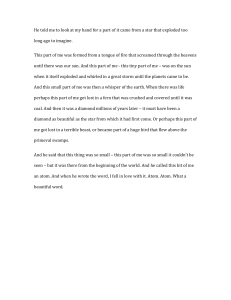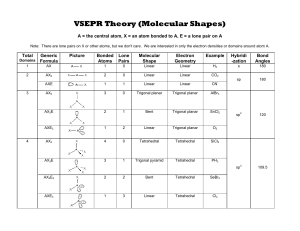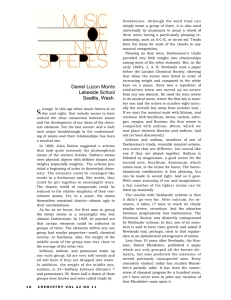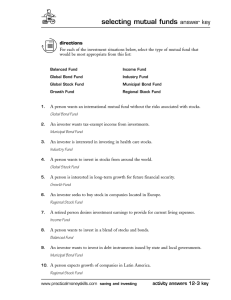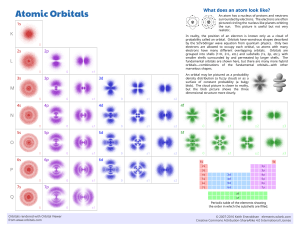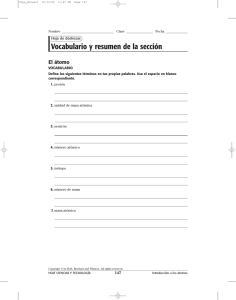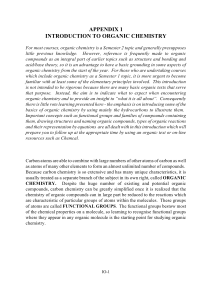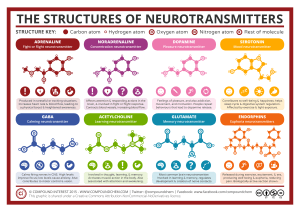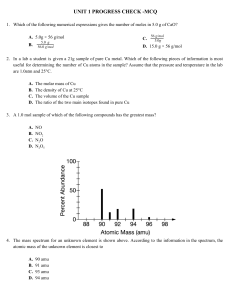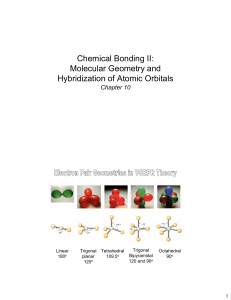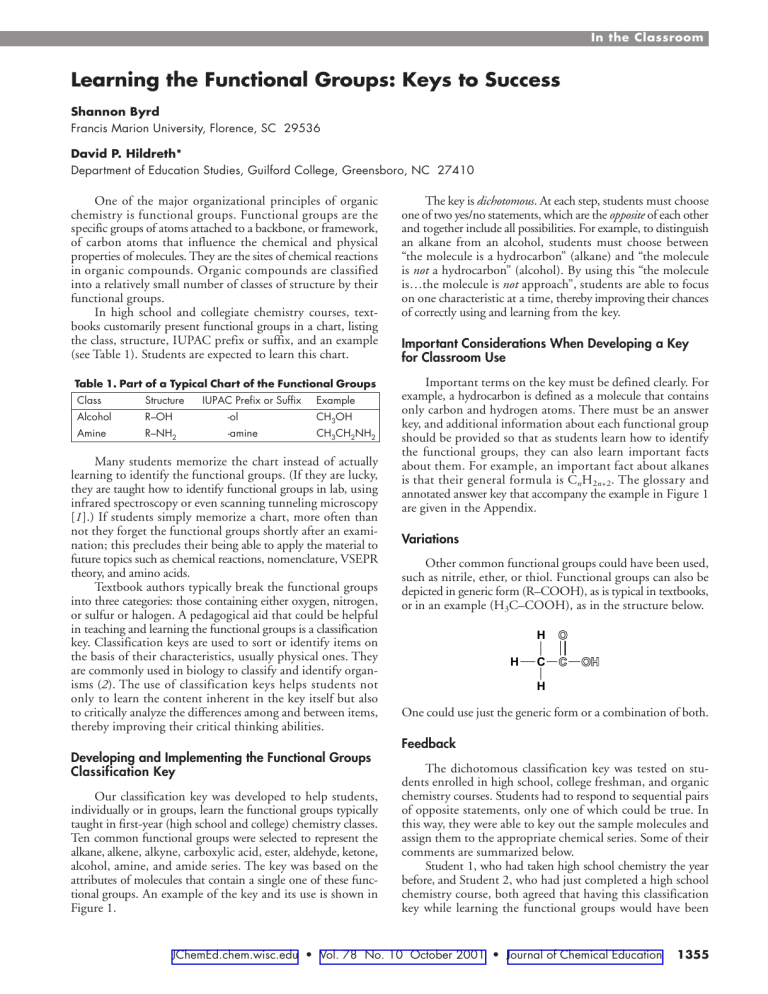
In the Classroom Learning the Functional Groups: Keys to Success Shannon Byrd Francis Marion University, Florence, SC 29536 David P. Hildreth* Department of Education Studies, Guilford College, Greensboro, NC 27410 One of the major organizational principles of organic chemistry is functional groups. Functional groups are the specific groups of atoms attached to a backbone, or framework, of carbon atoms that influence the chemical and physical properties of molecules. They are the sites of chemical reactions in organic compounds. Organic compounds are classified into a relatively small number of classes of structure by their functional groups. In high school and collegiate chemistry courses, textbooks customarily present functional groups in a chart, listing the class, structure, IUPAC prefix or suffix, and an example (see Table 1). Students are expected to learn this chart. The key is dichotomous. At each step, students must choose one of two yes/no statements, which are the opposite of each other and together include all possibilities. For example, to distinguish an alkane from an alcohol, students must choose between “the molecule is a hydrocarbon” (alkane) and “the molecule is not a hydrocarbon” (alcohol). By using this “the molecule is…the molecule is not approach”, students are able to focus on one characteristic at a time, thereby improving their chances of correctly using and learning from the key. Table 1. Part of a Typical Chart of the Functional Groups Important terms on the key must be defined clearly. For example, a hydrocarbon is defined as a molecule that contains only carbon and hydrogen atoms. There must be an answer key, and additional information about each functional group should be provided so that as students learn how to identify the functional groups, they can also learn important facts about them. For example, an important fact about alkanes is that their general formula is CnH2n+2. The glossary and annotated answer key that accompany the example in Figure 1 are given in the Appendix. Class Structure IUPAC Prefix or Suffix Example Alcohol R–OH -ol CH3OH Amine R–NH2 -amine CH3CH2NH2 Many students memorize the chart instead of actually learning to identify the functional groups. (If they are lucky, they are taught how to identify functional groups in lab, using infrared spectroscopy or even scanning tunneling microscopy [1].) If students simply memorize a chart, more often than not they forget the functional groups shortly after an examination; this precludes their being able to apply the material to future topics such as chemical reactions, nomenclature, VSEPR theory, and amino acids. Textbook authors typically break the functional groups into three categories: those containing either oxygen, nitrogen, or sulfur or halogen. A pedagogical aid that could be helpful in teaching and learning the functional groups is a classification key. Classification keys are used to sort or identify items on the basis of their characteristics, usually physical ones. They are commonly used in biology to classify and identify organisms (2). The use of classification keys helps students not only to learn the content inherent in the key itself but also to critically analyze the differences among and between items, thereby improving their critical thinking abilities. Important Considerations When Developing a Key for Classroom Use Variations Other common functional groups could have been used, such as nitrile, ether, or thiol. Functional groups can also be depicted in generic form (R–COOH), as is typical in textbooks, or in an example (H3C–COOH), as in the structure below. H H O C C OH H One could use just the generic form or a combination of both. Feedback Developing and Implementing the Functional Groups Classification Key Our classification key was developed to help students, individually or in groups, learn the functional groups typically taught in first-year (high school and college) chemistry classes. Ten common functional groups were selected to represent the alkane, alkene, alkyne, carboxylic acid, ester, aldehyde, ketone, alcohol, amine, and amide series. The key was based on the attributes of molecules that contain a single one of these functional groups. An example of the key and its use is shown in Figure 1. The dichotomous classification key was tested on students enrolled in high school, college freshman, and organic chemistry courses. Students had to respond to sequential pairs of opposite statements, only one of which could be true. In this way, they were able to key out the sample molecules and assign them to the appropriate chemical series. Some of their comments are summarized below. Student 1, who had taken high school chemistry the year before, and Student 2, who had just completed a high school chemistry course, both agreed that having this classification key while learning the functional groups would have been JChemEd.chem.wisc.edu • Vol. 78 No. 10 October 2001 • Journal of Chemical Education 1355 In the Classroom very helpful when they were taking chemistry. Student 1 said that when he had to learn the functional groups using the chart, he just memorized them, not really knowing the difference between them. He stated that the key would help students to actually learn to identify the functional groups and not just memorize them. The additional information on each functional group was also a helpful learning aid, stated Student 1. Student 2 commented that having actual examples was better than having the generic form (e.g., R–COOH). Student 3, who was currently taking general chemistry in college, commented that the key was easy to follow and fill in. Student 3 also stated that the additional information on each functional group was helpful. After Student 4, who had a bachelor’s degree in Biology, filled in the classification key, she asked, “Why didn’t you give this to me when I was taking organic?” Student 5, who was taking organic chemistry, stated H H H C H C H C H H H H H O C C H H CH3CH2CH3 C C A classification key offers teachers an alternative to tables for teaching the functional groups. In addition, by using a different approach, teachers may be able to better accommodate students’ various learning styles. As is evident by the comments provided by students, learning the functional groups with the aid of a classification key may be a key to success! Literature Cited 1. Giancarlo, L.; Fang, H.; Avila, L.; Fine, L.; Flynn, G. J. Chem. Educ. 2000, 77, 66–71. 2. Seevers, E. R. Science Activities 1978, 15 (4), 23–25. H H H H CH3COOH Conclusion O H OH that the key was a “more helpful way to learn” the functional groups than learning and memorizing from a chart. C H CHCH CH3COH O C H H C C H H3C OH H C C H H H H O H C C H H H C C N H H H O NH2 OH 1 H CH3CH2NH2 CH3COCH3 OH O H H H CH3CHCH2 CH3CH2OH H C 2 4 3 5 8 7 6 Classify these ten molecules and write the number of the molecule into the box. Molecule is a hydrocarbon. H Molecule is not a hydrocarbon. H O C C H O C H H CH3COOCH3 Only has single bonded carbon atoms. Does not only have single bonded carbon atoms. The carbon atom bonded to the nitrogen atom is also double bonded to an oxygen atom. alkane 2 Has a sp hybridized carbon. Does not have a sp 2hybridized carbon but a sphybridized carbon. The carbon atom bonded to the nitrogen atom is not also double bonded to an oxygen atom. Does not have two oxygen atoms. Has an oxygen atom bonded to a sp 3- hybridized carbon atom. amine amide Has an oxygen atom not bonded to a 3 sp - hybridized carbon atom. alcohol Has C=O with an OH group. alkene O 9 Has two oxygen atoms. Has C=O without an OH group. alkyne carboxylic acid C atom in C=O is bonded to two other carbon atoms. C atom in C=O is not bonded to two other carbon atoms. ester ketone aldehyde Figure 1. The classification key and exercise for functional groups. 1356 H H O C C N H H CH3CONH2 O O Does not have a nitrogen atom. Has a nitrogen atom. H Journal of Chemical Education • Vol. 78 No. 10 October 2001 • JChemEd.chem.wisc.edu NH2 10 H In the Classroom Appendix Glossary Hydrocarbon—a molecule that contains only hydrogen (H) and carbon (C) atoms. sp2-Hybridized—consists of double bonds, e.g. C=C. Only two of the three p orbitals are used to form sp2 hybrid orbitals; bond angle is 120°; consists of one sigma (σ) bond and one pi (π) bond. sp3-Hybridized—consists of single bonds, e.g. C–C. A set of hybrid orbitals constructed from one s orbital and three p orbitals; bond angle is 109.5°; consists of one σ bond. sp-Hybridized—consists of triple bonds, e.g. C≡C. The hybrid orbital consists of only one of the three p orbitals; consists of one σ bond and two π bonds; bond angle is 180°. Hybrid orbitals—orbitals used to describe bonding, obtained by taking combinations of atomic orbitals of the isolated atoms. Sigma (σ) bond—has a cylindrical shape about the bond axis. Formed either when two s orbitals overlap or when an orbital with directional character, such as a p orbital or a hybrid orbital, overlaps another orbital along the interatomic axis. Pi (π) bond—has an electron distribution above and below the bond axis. OH —hydroxyl group. C=O —carbonyl group. –NH2 —amino group. Annotated Answer Key A. Alkane A1. example is propane [C3H8], 1 A2. single-bonded C atoms A3. saturated C atoms A4. carbon atoms can be bonded in chains or rings A5. sp3-hybridized carbon atoms A6. bonded either to other carbon atoms or to hydrogen atoms A7. each compound’s name has suffix -ane A8. have densities between 0.6 and 0.8 g cm᎑3 A9. pure alkanes are colorless, tasteless, and nearly odorless A10. nonpolar A11. not soluble in water A12. general formula CnH2n+2 when bonded in a chain A13. low-molecular-weight alkanes are gaseous fuels at room temperature (methane, propane, ethane, butane) A14. rotate freely when bonded in a chain A15. undergo halogenation and oxidation reactions B. Alkene B1. example is propene (methylethylene) [C3H6 or CH3–CH=CH2], 6 B2. unsaturated carbon atoms B3. double-bonded carbon atoms B4. general formula CnH2n B5. insoluble in water B6. soluble in nonpolar solvents B7. each compound’s name has suffix -ene B8. restricted rotation B9. geometric isomers B10. undergo addition of HX to the double bond and hydrogenation C. Alkyne C1. example is ethyne [C2H2], 4 C2. each compound’s name has suffix -yne C3. triple-bonded carbon atoms C4. sp-hybridized C5. bond angle 180° C6. unsaturated carbon atoms C7. undergo hydrogenation and halogenation C8. general formula CnH2n–2 D. Amide D1. example is ethanamide [CH3CONH2], 10 D2. form strong intermolecular hydrogen bonds between the amide hydrogen atom of one molecule and the carbonyl oxygen atom of a second molecule, resulting in high melting and boiling points D3. amides with low molecular weights dissolve in water D4. nitrogen atom is bonded to an sp2-hybridized carbon atom E. Amine E1. example is ethanamine or ethylamine [CH3CH2NH2], 8 E2. derivative of ammonia in which one or more hydrogen atoms are replaced by alkyl or aryl groups E3. nitrogen atom is bonded to an sp3-hybridized carbon atom E4. smells like dead fish F. Carboxylic acid F1. example is ethanoic (acetic) acid [CH3COOH], 2 F2. contains carbonyl group and –OH group attached to the carbonyl carbon F3. each compound’s name has suffix -oic and term acid F4. undergo neutralization of base, esterification, and hightemperature decomposition reactions G. Ester G1. example is methyl ethanoate [CH3COOCH3], 9 G2. the carbonyl carbon atom is bonded to an alkoxy group such as –OCH3 G3. undergo acid hydrolysis and saponification reactions G4. smells sweet H. Alcohol H1. example is ethanol [CH3CH2OH], 5 H2. each compound’s name has suffix -ol H3. organic compound with hydroxyl group bonded to sp3hybridized carbon atom H4. undergo oxidation to form aldehydes or ketones, dehydration to form alkenes, formation of esters, conversion to halides I. Ketone I1. example is propanone [CH3COCH3], 7 I2. carbonyl group C=O I3. each compound’s name has suffix -one I4. undergo reactions with Grignard reagents, HCN, and alcohols J. Aldehyde J1. example given is ethanal (acetaldehyde) [CH3CHO], 3 J2. contains carbonyl group J3. compound’s name has suffix -al J4. bond angles around the carbonyl carbon atom are approximately 120°; sp2-hybridized C J5. the lower-molecular-weight compounds dissolve in water in all proportions J6. undergo reactions with Grignard reagents, HCN, and alcohols JChemEd.chem.wisc.edu • Vol. 78 No. 10 October 2001 • Journal of Chemical Education 1357
